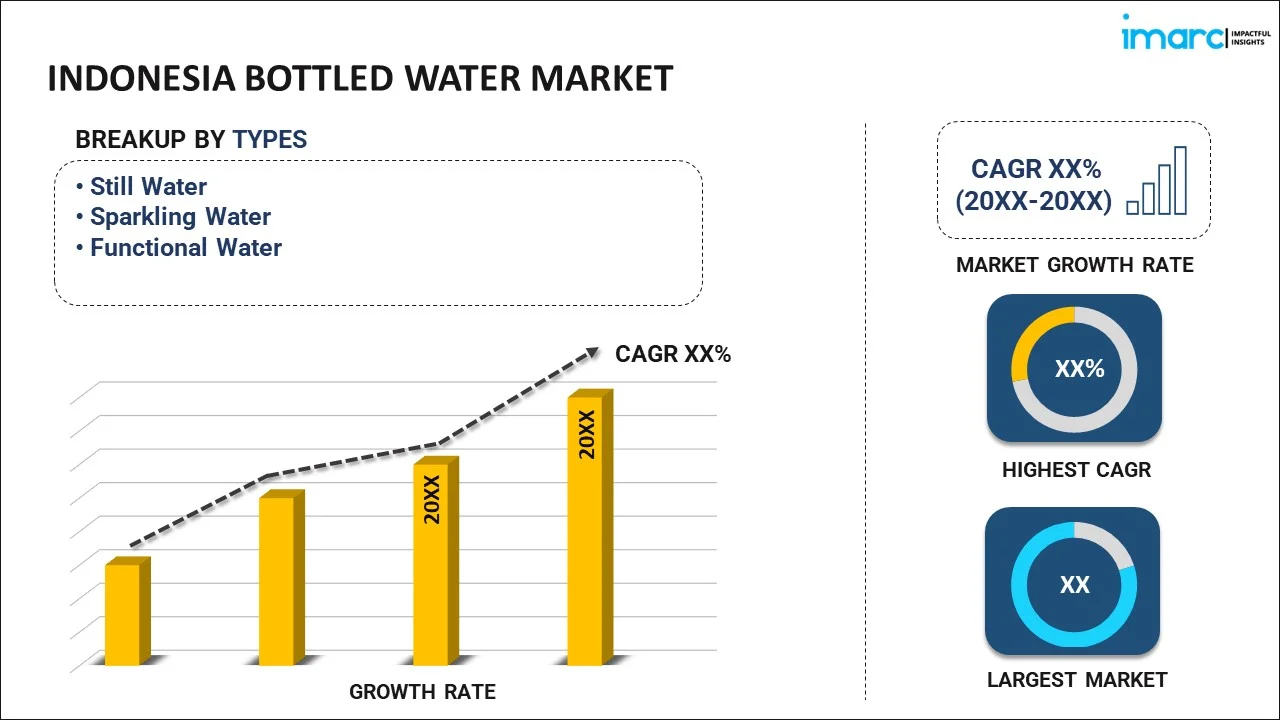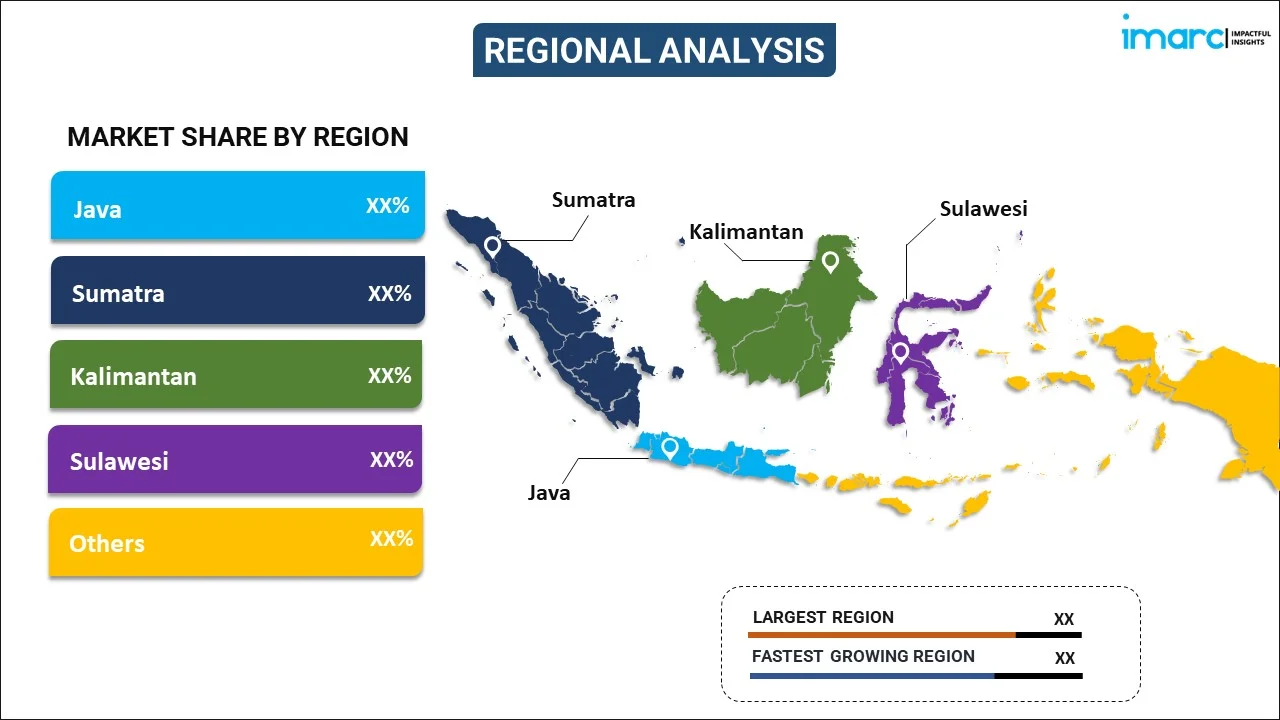
Indonesia Bottled Water Market Report by Type (Still Water, Sparkling Water, Functional Water), Distribution Channel (Supermarkets/Hypermarkets, Convenience Stores, Online Retailers, On-trade, and Others), and Region 2024-2032
Market Overview:
Indonesia bottled water market size reached US$ 298.1 Million in 2023. Looking forward, IMARC Group expects the market to reach US$ 582.4 Million by 2032, exhibiting a growth rate (CAGR) of 7.47% during 2024-2032. The increasing concerns regarding water quality and safety, rapid urbanization and changing lifestyles, growing awareness about the health and wellness among consumers, expanding tourism sector of the country, expanding middle class population, ongoing infrastructure development represent some of the key factors driving the market.
|
Report Attribute
|
Key Statistics
|
|---|---|
|
Base Year
|
2023 |
|
Forecast Years
|
2024-2032 |
|
Historical Years
|
2018-2023
|
|
Market Size in 2023
|
US$ 298.1 Million |
|
Market Forecast in 2032
|
US$ 582.4 Million |
| Market Growth Rate 2024-2032 | 7.47% |
Bottled water refers to drinking water that is packaged in plastic or glass containers for convenient consumption. It is typically sourced from springs, wells, or municipal supplies, then subjected to a series of processes such as filtration, disinfection, and purification to ensure its quality and safety for human consumption. This industry has witnessed substantial growth due to the convenience it offers in providing potable water on the go, especially in areas where access to safe tap water might be limited. While various types of bottled water exist, including mineral water, purified water, spring water, and artesian water, the key distinction lies in their origins and treatment processes. Consumers often opt for bottled water as an alternative to tap water, either for its perceived purity or taste preferences.
Indonesia Bottled Water Market Trends:
The increasing concerns regarding water quality and safety have been a primary factor driving the bottled water market in Indonesia. With the persisting challenges related to water contamination and inconsistent access to safe drinking water in certain regions, consumers are turning to bottled water as a reliable source of clean and potable drinking water. Additionally, the rising urbanization and changing lifestyles in Indonesia have led to a rise in the demand for convenient and readily available potable water. As urban populations continue to grow, the need for on-the-go hydration solutions has become more pronounced, propelling the consumption of bottled water across various demographic segments. Other than this, the growing awareness of health and wellness among consumers has fostered a shift toward healthier beverage choices, including bottled water. As individuals increasingly prioritize their well-being, the perception of bottled water as a healthier alternative to sugary beverages has bolstered its demand, particularly among health-conscious consumers and fitness enthusiasts. Besides this, the tourism sector in Indonesia has played a pivotal role in driving the demand for bottled water. As the country attracts a substantial number of domestic and international tourists, the need for convenient and safe drinking water options has intensified, leading to a significant upsurge in the consumption of bottled water within the hospitality and tourism industry. In line with this, the expanding middle-class population and the subsequent increase in disposable income is creating a positive market outlook. As more individuals join the middle-income bracket, there has been a noticeable shift in consumer spending patterns, with a growing inclination toward premium and branded bottled water products. This trend has led to an elevation in the overall market demand and a preference for higher-quality offerings. Furthermore, the prevalent tropical climate in Indonesia has contributed significantly to the demand for bottled water. The high temperatures and humid conditions of the region throughout the year have augmented the need for adequate hydration, thereby driving the consumption of bottled water across various regions, both urban and rural.
Indonesia Bottled Water Market Segmentation:
IMARC Group provides an analysis of the key trends in each segment of the market, along with forecasts at the country level for 2024-2032. Our report has categorized the market based on type and distribution channel.
Type Insights:

- Still Water
- Sparkling Water
- Functional Water
The report has provided a detailed breakup and analysis of the market based on the type. This includes still water, sparkling water, and functional water.
Distribution Channel Insights:
- Supermarkets/Hypermarkets
- Convenience Stores
- Online Retailers
- On-trade
- Others
A detailed breakup and analysis of the market based on the distribution channel have also been provided in the report. This includes supermarkets/hypermarkets, convenience stores, online retailers, on-trade, and others.
Regional Insights:

- Java
- Sumatra
- Kalimantan
- Sulawesi
- Others
The report has also provided a comprehensive analysis of all the major regional markets, which include Java, Sumatra, Kalimantan, Sulawesi, and Others.
Competitive Landscape:
The market research report has also provided a comprehensive analysis of the competitive landscape in the market. Competitive analysis such as market structure, key player positioning, top winning strategies, competitive dashboard, and company evaluation quadrant has been covered in the report. Also, detailed profiles of all major companies have been provided.
Indonesia Bottled Water Market Report Coverage:
| Report Features | Details |
|---|---|
| Base Year of the Analysis | 2023 |
| Historical Period | 2018-2023 |
| Forecast Period | 2024-2032 |
| Units | US$ Million |
| Scope of the Report | Exploration of Historical Trends and Market Outlook, Industry Catalysts and Challenges, Segment-Wise Historical and Future Market Assessment:
|
| Types Covered | Still Water, Sparkling Water, Functional Water |
| Distribution Channels Covered | Supermarkets/Hypermarkets, Convenience Stores, Online Retailers, On-trade, Others |
| Regions Covered | Java, Sumatra, Kalimantan, Sulawesi, Others |
| Customization Scope | 10% Free Customization |
| Report Price and Purchase Option | Single User License: US$ 3699 Five User License: US$ 4699 Corporate License: US$ 5699 |
| Post-Sale Analyst Support | 10-12 Weeks |
| Delivery Format | PDF and Excel through Email (We can also provide the editable version of the report in PPT/Word format on special request) |
Key Questions Answered in This Report:
- How has the Indonesia bottled water market performed so far and how will it perform in the coming years?
- What has been the impact of COVID-19 on the Indonesia bottled water market?
- What is the breakup of the Indonesia bottled water market on the basis of type?
- What is the breakup of the Indonesia bottled water market on the basis of distribution channel?
- What are the various stages in the value chain of the Indonesia bottled water market?
- What are the key driving factors and challenges in the Indonesia bottled water?
- What is the structure of the Indonesia bottled water market and who are the key players?
- What is the degree of competition in the Indonesia bottled water market?
Key Benefits for Stakeholders:
- IMARC’s industry report offers a comprehensive quantitative analysis of various market segments, historical and current market trends, market forecasts, and dynamics of the Indonesia bottled water market from 2018-2032.
- The research report provides the latest information on the market drivers, challenges, and opportunities in the Indonesia bottled water market.
- Porter's five forces analysis assist stakeholders in assessing the impact of new entrants, competitive rivalry, supplier power, buyer power, and the threat of substitution. It helps stakeholders to analyze the level of competition within the Indonesia bottled water industry and its attractiveness.
- Competitive landscape allows stakeholders to understand their competitive environment and provides an insight into the current positions of key players in the market.
Need more help?
- Speak to our experienced analysts for insights on the current market scenarios.
- Include additional segments and countries to customize the report as per your requirement.
- Gain an unparalleled competitive advantage in your domain by understanding how to utilize the report and positively impacting your operations and revenue.
- For further assistance, please connect with our analysts.
 Inquire Before Buying
Inquire Before Buying
 Speak to an Analyst
Speak to an Analyst
 Request Brochure
Request Brochure
 Request Customization
Request Customization




.webp)




.webp)












